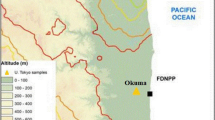Abstract
The possibility to obtain new information about the U/Th contamination using the patterns of the fission track micromapping is put into evidence. For the investigated samples, bed load sediments sampled from Danube river and Delta, fission track micromappings were obtained using the neutron-induced fission of the U and Th elements and the track registration of their fission fragments in muscovite track detectors. Utilising the optical microscopy, these micromappings were used both for U and Th content measurements and for studies of U/Th atom distributions. Considering the “track micromapping pattern” as a characteristic of the U/Th atom distribution in the analysed sample, and basing on the micromapping patterns that were previously obtained for the samples contaminated in the specific conditions, the authors were able to establish: (1) the presence of the contamination of the sediments in spite of the fact that the U/Th concentration values did not exceed the natural background values, (2) the solubility of the U/Th chemical compounds in the initial waste and (3) the presence of a succession of U/Th contaminations as well as the presence of the transported contamination.
Similar content being viewed by others
References
UNSCEAR Report: Sources and Effects of Ionizing Radiations 1993.
R. L. Fleischer, P. B. Price, R. M. Walker, Nuclear Tracks in Solids, University of California Press, New York, 1975, Chapter 8.
A. Danis, U and Th content measurements in liquid and solid samples, Homologated method No. 433/1982, Institute of Physics and Nuclear Engineering, Bucharest, 1983 (in Romanian).
A. Danis, Low level U and Th measurements by the fission track method; Report 65-90-42, Institute of Physics and Nuclear Engineering, 1983 (in Romanian).
A. Danis, D. Dorcioman, St. Cerc. Fiz., 39 (1987) No. 6, 471.
Reference Materials 1994–1995. Analytical Quality Control Services, Seibersdorf Laboratory, Vienna, 1995.
A. D. Anis, D. Dorcioman, A. Ponta, Nucl. Tracks, 12 (1986) Nos 1–6, 785.
I. I. Georgescu, A. Pantelica, M. Salagean, Rapp. Comm. Int. Mer. Medit., 33 (1992) 275.
A. Pantelica, M. Salagean, I. I. Georgescu, Rapp. Comm. int. Mer. Medit., 34 (1995) 67.
I. I. Georgescu, A. Pantelica, M. Salagean, On the radioactivity of bed load sediments of Danube river during 1994, 3rd Intern. Meeting Nuclear Physics for Protection of the Environment, Dubna, Russia, May 23–28, 1995, in press.
Author information
Authors and Affiliations
Rights and permissions
About this article
Cite this article
Georgescu, I.I., Danis, A.S. & Mihai, AS.G. New information about the U/Th sediment contamination provided by the neutron-induced fission activation analysis. J Radioanal Nucl Chem 216, 253–260 (1997). https://doi.org/10.1007/BF02033787
Received:
Issue Date:
DOI: https://doi.org/10.1007/BF02033787




